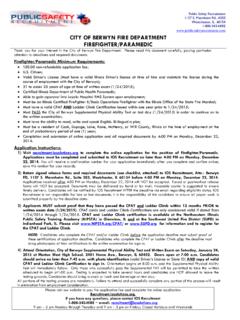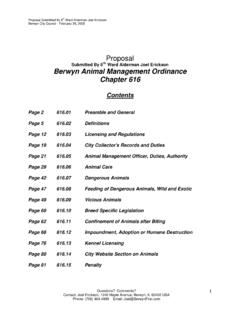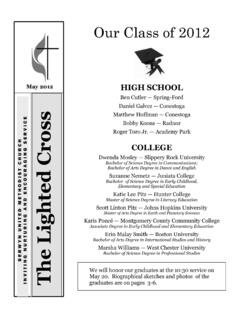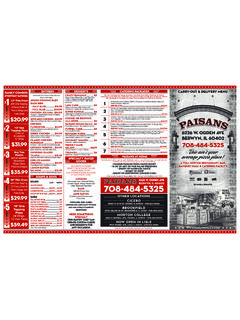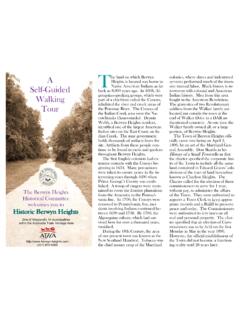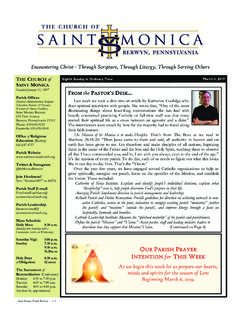Transcription of BERWYN PAST-TIMES - Berwyn Historical Society
1 BER WYN PAST- T IM ES SUMMER 2004 / VOLUME 25, NUMBER 2 A PUBLICATION OF THE BERWYN Historical Society BOX 479 / BERWYN , ILLINOIS 60402 Horse-Drawn Wagons, Trains, and Automobiles By John Humiston Editor s note: Recently, I was looking through the BHS archives for interesting items worth publishing, and I came across this gem of a letter from the brother of C. Cutler Humiston. It came to us after he had read through the Spring 1997 PAST-TIMES featuring Cutler s submission, Memories of South BERWYN . As I read through both articles, there were minor differences such as the mention of the same car a Dort from Rhue Motor Sales or a Dart from Roo Motor Sales but have chosen not to correct these minor details to conform to the previous publishing.
2 I hope your imagination will be as busy as mine was as you see the streets of BERWYN from a bygone era. Mr. John Humiston has passed on since the time of his writing, but his memories remain..South BERWYN streets were paved with macadam, mixed sizes of crushed stone firmly compacted and sometimes bound with asphalt or tar. Curbs were slabs of cut sandstone about four inches thick, two feet high, and five feet long embedded edgewise in the ground at the edges of the pavement. Thirty-fourth Street carried the principal east-west traffic from Ridgeland to Harlem where the pavement ended.
3 Harlem had two trolley tracks centered on the boundary with Riverside, but there was no street. A rutted dirt road crossed the trolley tracks and then paralleled the tracks south to a connection with Lawton Road where traffic could continue west. The pavement on 34th Street had broken up in front of the George Norton home just west of Wenonah, becoming a deep, rutted mud hole. A similar condition existed farther east between Grove and Kenilworth. Most traffic was horse drawn. Dirt and construction materials usually moved in hopper bottom wagons.
4 Coal was deliv-ered in box bed wagons, which were remounted on bobsled runners in the wintertime. Milk and dairy products were delivered daily direct to each house by wagons. Some houses were served by wagons of the Bowman Dairy Company and others by wagons of Borden s. C. M. Moline s ice wagon was a popular vehicle in the summertime. The ice was in 1,000 pound blocks covered with canvas to retard melting. The iceman used a pick to cut off 25-, 50-, 75-, and 100-pound chunks as ordered which he carried to our back porch refrigerator using a pair of tongs. He wore a padded leather shoulder pad on which to rest the ice while carrying it.
5 Each house ordered ice for the day by displaying an ice card in the front window. Ice cards were of cardboard about 12 inches square and could be placed in four positions so that any of the numbers 25, 50, 75, or 100 could be on top to indicate the amount ordered. Thirty-fourth Street received a concrete pavement past our house in 1923. The work was done by the James A. Sackley Company of Chicago. First, a trenching machine dug a drainage ditch from east to west down the center, and then a tile sewer pipe was laid with connections to the curb drains. It was followed by a (Continued on page 2.)
6 (Continued from page 1.) steam-powered shovel which dug out the old pavement to provide a sub-grade for the new. Manufactured by the Thew Company in Ohio, the steam shovel was a fascinating machine. It had four steel travel wheels about thirty inches in diameter with about 12-inch treads under a rectangular steel frame. A circular track on top of the frame carried the machinery deck with a closed cab, a vertical steam boiler and counterweight in the rear, and a boom and shovel or dipper stick in the front. The operator controlled the shovel from a lever bank on the right front, while a fireman tended the boiler in the rear.
7 The deck machinery was driven by a steam engine whose exhaust was discharged up the boiler chimney to provide a draft for the fire. Through clutches, gears, and shafting, this engine provided the motion of travel, driving the carrying wheels with a vertical shaft down the center; the motion of rotation, or slewing of the machinery deck on the circular track; the motion of boom hoisting; and the motion of shovel hoisting. A second steam engine mounted halfway up the boom provided a fifth motion, the crowd, forcing the dipper stick in and out with a rack and pinion.
8 The steam exhausted from the crowd engine was discharged at the top of the boom. Because the travel wheels were unsuited for the dirt sub-grade, the shovel traveled on four timber slabs. To move forward, the machine would pick up the wood slab from behind, then swing it around and place it in front. It was an impressive machine to us young boys. Our neighbor Thomas White, then about six years old, asked his older sisters what the machine was, and they told him it was a belching derrick. To supply the concrete paver which followed, the 3300 block of Wisconsin Avenue became a material yard and crushed stone and sand were trucked in and dumped.
9 A steam-powered clamshell crane, similar in design to the shovel, raised the stone and sand into an elevated hopper mounted on wheels. A fleet of Clark Equipment Company Tructractors, small three-wheeled dump trucks, loaded at the hopper and carried the materials to the paver. Cement was added, and the concrete was mixed and placed on the sub-grade much the same as now. The Burlington was known as the Chicago, Burlington, & Quincy Railroad. Through-passenger trains to and from Kansas City, Omaha, Denver, and St. Paul raced through without stopping. Freight trains originated and terminated at Clyde as they do now, but were composed of lighter and fewer cars than today.
10 BERWYN had frequent commuter service serving the same three stations as today. There was also local freight service. The way-freight normally operated on the north track of the three, and would sometimes wait while a refrigerator car was opened while sides of beef (which were hung from hooks in the car ceiling) were unloaded for the local meat market probably Hamm s although I m not positive. The railroad had a turnout from the north track just east of Oak Park Avenue, with the switch points facing west, that led to a team track, a side track running east for two or three blocks. (Continued on page 3.)
